| The Cowdray Engravings | |
|---|---|
 |
The Cowdray engravings comprise five 18th-century engravings of 16th-century wall-paintings, originally commissioned by Sir Anthony Browne. The original paintings were destroyed by fire in 1793.
| The Cowdray Engravings | |
|---|---|
 |
The Cowdray engravings comprise five 18th-century engravings of 16th-century wall-paintings, originally commissioned by Sir Anthony Browne. The original paintings were destroyed by fire in 1793.
The Cowdray engravings are based on five paintings produced for Sir Anthony Browne, King Henry VIII's Master of the Horse. [1] They were probably produced between 1545 and 1548 and were painted onto the walls of Browne's hall in Cowdray House. [2] They showed key scenes in his life and might have been used by him when recounting stories during formal events. The painting included The Departure of King Henry VIII from Calais, The Encampment of King Henry VIII at Marquison, The Siege of Boulogne by King Henry VIII, The Encampment of the English forces near Portsmouth and The riding of King Edward VI from the Tower of London to Westminster. [1]
Philip Yorke, the Earl of Hardwick and a keen antiquarian, proposed producing engravings of the paintings in the 1760s. [3] His colleague, the antiquarian Sir Joseph Ayloffe, was spurred on by his interest and convinced the Society of Antiquaries to record them as engravings, as part of a longer series of historical prints produced by the society. [4] The Encampment of the English Forces near Portsmouth was rendered as a watercolour by John and Charles Sherwin and then engraved by James Basire. Samuel Hieronymous Grimm copied the remaining four paintings which Basire then engraved. [1] The engravings were published in 1788 with a print run of 400 copies, distributed to fellow of the society and sold to the public. [5]
Cowdray House burnt down on 24 September 1793 and the paintings were mostly destroyed as the rendering came away from the walls, although some fragments may have survived for a few years after the fire. [6] This left the engravings as the only record. [2] The historian Bernard Nurse considers them to be "an important record of the sixteenth-century originals". [6]
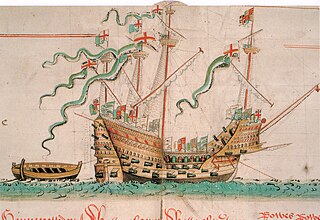
The Mary Rose was a carrack in the English Tudor navy of King Henry VIII. She was launched in 1511 and served for 33 years in several wars against France, Scotland, and Brittany. After being substantially rebuilt in 1536, she saw her last action on 19 July 1545. She led the attack on the galleys of a French invasion fleet, but sank in the Solent, the strait north of the Isle of Wight.

Mary Tudor was an English princess who was briefly Queen of France as the third wife of King Louis XII. Louis was more than 30 years her senior. Mary was the fifth child of Henry VII of England and Elizabeth of York, and the youngest to survive infancy.

George Vertue was an English engraver and antiquary, whose notebooks on British art of the first half of the 18th century are a valuable source for the period.

The Society of Antiquaries of London (SAL) is a learned society "charged by its Royal Charter of 1751 with 'the encouragement, advancement and furtherance of the study and knowledge of the antiquities and history of this and other countries'." It is based at Burlington House, Piccadilly, London, and is a registered charity.
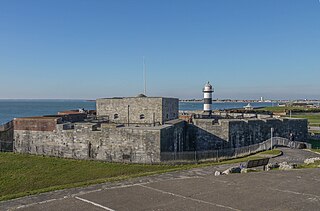
Southsea Castle, historically also known as Chaderton Castle, South Castle and Portsea Castle, is an artillery fort originally constructed by Henry VIII on Portsea Island, Hampshire, in 1544. It formed part of the King's Device programme to protect against invasion from France and the Holy Roman Empire, and defended the Solent and the eastern approach to Portsmouth. The castle had a square central keep, two rectangular gun platforms to the east and west, and two angled bastions to the front and rear, and was an early English example of the trace italienne-style of fortification popular on the Continent. The Cowdray engraving of the Battle of the Solent in 1545 depicted Henry VIII visiting the castle. Despite several serious fires, it remained in service and saw brief action at the start of the English Civil War in 1642 when it was stormed by Parliamentary forces.

The First Siege of Boulogne took place from 19 July to 14 September 1544 and the Second Siege of Boulogne took place in October 1544.
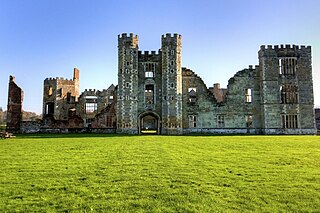
Cowdray House consists of the ruins of one of England's great Tudor houses, architecturally comparable to many of the great palaces and country houses of that time. It is situated in the parish of Easebourne, just east of Midhurst, West Sussex standing on the north bank of the River Rother. It was largely destroyed by fire on 24 September 1793, but the ruins have nevertheless been Grade I listed.

Maurice Boitel was a French painter.

The Anthony Roll is a written record of ships of the English Tudor navy of the 1540s, named after its creator, Anthony Anthony. It originally consisted of three rolls of vellum, depicting 58 naval vessels along with information on their size, crew, armament, and basic equipment. The rolls were presented to King Henry VIII in 1546, and were kept in the royal library. In 1680 King Charles II gave two of the rolls to Samuel Pepys, who had them cut up and bound as a single volume book, which is now in the Pepys Library at Magdalene College, Cambridge. The third roll remained in the royal collection until it was given by King William IV to his daughter Lady Mary Fox, who sold it to the British Museum in 1858; it is now owned by the British Library.

Sir Anthony Browne, KG of Battle Abbey and Cowdray Park, both in Sussex, England, was a Member of Parliament and a courtier who served as Master of the Horse to King Henry VIII.
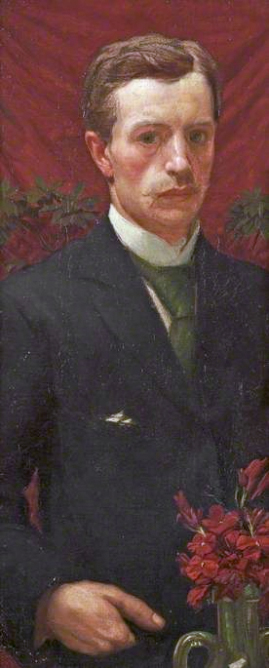
Henry Albert Payne RWS, also known as "Henry Arthur Payne", was a British stained glass artist, watercolourist and painter of frescoes.

Vice-Admiral, Sir George Carew was an English soldier, admiral and adventurer during the reign of King Henry VIII who died in the sinking of the Royal Navy flagship Mary Rose at the Battle of the Solent during an attempted French invasion in the Italian War of 1542–1546. Scion of a controversial and dramatic family, Carew had a wild youth and explored widely, being arrested several times for associating with rebellious vassals of the king. Carew successfully tamed this nature in his later years, during which he became a trusted advisor and military officer in the King's service.
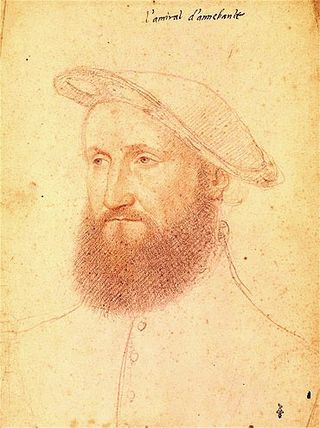
Claude d'Annebault was a French military officer; Marshal of France (1538–52); Admiral of France (1543–1552); and Governor of Piedmont in 1541. He led the French invasion of the Isle of Wight in 1545. Annebault was governor of Normandy and a very powerful figure during the reign of King Francis.

Peter Pomegranate was a warship of the English Tudor navy, built in 1510. Her name most likely was in honour of Saint Peter and the badge of Queen Catherine of Aragon, a pomegranate.
David Michael Loades was a British historian specialising in the Tudor era. He was Emeritus Professor of History at the University of Wales, where he taught from 1980 until 1996, and was Honorary Research Professor at the University of Sheffield from 1996 until 2008. In the 1960s and 1970s he taught at the universities of St. Andrews and Durham. From 1993 until 2004 he acted as Literary Director of the John Foxe Project at the British Academy; he subsequently became an Honorary Member of the History Faculty at the University of Oxford. After military service in the Royal Air Force 1953–1955, Loades studied at the University of Cambridge. He wrote many books on the Tudor period, including biographies. He was President of the Ecclesiastical History Society (1992–93).
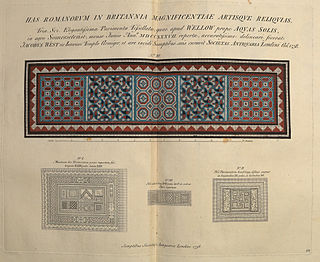
Vetusta Monumenta is the title of a published series of illustrated antiquarian papers on ancient buildings, sites and artefacts, mostly those of Britain, published at irregular intervals between 1718 and 1906 by the Society of Antiquaries of London. The folio-sized papers, usually written by members of the society, were first published individually, and then later in collected volumes.

Samuel A. Rayner was an English landscape artist, known for his paintings of buildings and their interiors, including abbeys, churches and old mansions. He achieved the distinction of having a work accepted for exhibition at the Royal Academy at the age of 15. His wife, Ann Rayner, was an engraver on Ashford Black Marble and six of their children went on to be professional artists.

Edward Duncan was a British watercolourist known for his depictions of coastal views and shipping. He was a member of the Royal Watercolour Society and received Royal patronage from Queen Victoria.
Annie Pearson, Viscountess Cowdray, GBE was an English society hostess, suffragist and philanthropist. She was nicknamed the "Fairy Godmother of Nursing" due to her financial patronage of the Royal College of Nursing and her work to promote district nursing throughout England and Scotland. She served as the President of the Women's Liberal Federation from 1921 until 1923 and was also the Honorary Treasurer of the Liberal Women's Suffrage Union. She was the only woman to hold the office of High Steward of Colchester, serving from 1927 until her death in 1932.